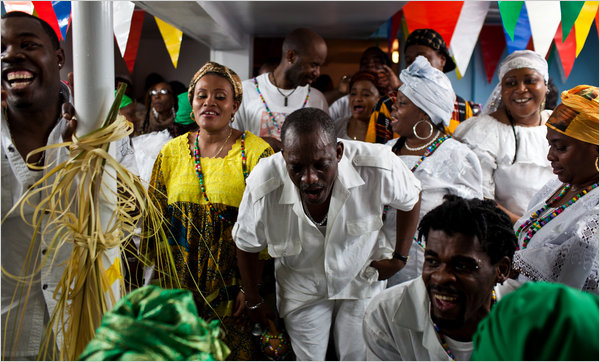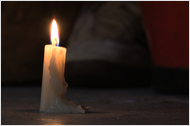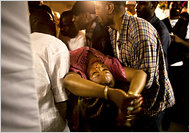IT was past 3 a.m. in a dim basement in Flatbush, Brooklyn, and Jack Laroche, a Haitian-American computer engineer, nervously awaited his bride: a voodoo spirit named Ezili Freda who believers say has the power to lavish love and wealth and render wayward spouses impotent.
Multimedia
As four drummers pounded rhythmically, voodoo priestesses in bright-colored dresses danced in ecstatic circles, dousing the floor with rum and chanting, “Ayibobo!” — the voodoo “amen.” The bride’s dramatic entrance was signaled when a priestess in a shimmering pink silk dress started trembling violently, her eyes rolling toward the back of her head before she fainted. When she came to, apparently possessed by Ezili Freda, she took Mr. Laroche’s hand and nibbled on his ear coquettishly before the happy couple exchanged vows in French.
Long misunderstood and maligned in Western popular culture, voodoo has become a spiritual anchor in New York City’s vast Haitian community and in Haitian enclaves across the country as practitioners look for comfort after the devastating earthquake in the impoverished Caribbean nation last year.
In New York, where there are roughly 300,000 people who were born in Haiti or are of Haitian descent — the largest concentration in the United States — richly painted basement voodoo temples are sprinkled around Harlem and in parts of Brooklyn and Queens. Mambos, or voodoo priestesses, say they can barely keep up with “demann,” or prayer requests; spiritual love recipes to lure recalcitrant lovers are the most popular. Voodoo prayer circles in which practitioners meet to commiserate have also proliferated, with a notable intensity in the months since the earthquake.
But the world of voodoo has fallen under an unwelcome spotlight in recent weeks as a result of two episodes in which the authorities say voodoo played a central role — a fatal five-alarm fire in Brooklyn and the coming trial in Queens of a woman accused of severely burning her daughter.
The fire, in a building in Flatbush in February, was ignited by candles surrounding a bed during a ceremony in the apartment of a voodoo priest who the authorities said was hired by a woman to chase away evil spirits. The fire killed a 64-year-old woman in another apartment and left dozens of tenants homeless.
In Queens, a Haitian immigrant, Marie Lauradin, 29, is to go on trial this summer because prosecutors say she performed a voodoo exorcism ritual two years ago during which she lighted a flammable liquid in the form of a circle on a floor and placed her 6-year-old daughter, Frantzcia, within it, engulfing her in flames. Ms. Lauradin is charged with assault and endangering the welfare of a child.
The child’s grandmother Sylvenie Thessier, 72, whom prosecutors accused of doing nothing while her granddaughter was burned, was sentenced last week to one to three years in prison after pleading guilty to reckless endangerment.
The episodes have shaken the tight-knit and largely secretive voodoo community in New York, and practitioners say they were aberrant acts perpetrated by ignorant people who were abusing the religion.
Dowoti Desir, a Haitian-American voodoo scholar who has a temple in her home in Harlem, said the episodes were contributing to the demonization of voodoo and forcing people to practice it underground.
“Voodoo practitioners are in the closet for fear of being hounded or suffering reprisals,” she said. “The truth is that voodoo has been a source of empowerment for generations of Haitians.” (Many practitioners and scholars prefer alternate renderings of the word “voodoo,” like “voudou” or “vodun,” which they say more accurately reflect its origins.)
Some people are turning to voodoo in response to financial hardships caused by the recession. And among younger Haitian-Americans, voodoo is a means to reconnect with their roots.
Mr. Laroche, 35, nattily dressed for his marriage ceremony, said he had decided to exchange vows with his spirit bride in search of cultural affirmation, career advancement and protection from affliction, financial or otherwise. “There is a misconception that if you practice voodoo you can turn your friends into goats,” Mr. Laroche said. “But voodoo is about getting back in touch with the past.”
In voodoo, a healing-based religion that was brought to Haiti by slaves from Western and Central Africa, followers commune with one God — Gran Met — by worshiping potent and sometimes temperamental lwas, or spirits, believed to hold sway over love, morality, reproduction and death.
As four drummers pounded rhythmically, voodoo priestesses in bright-colored dresses danced in ecstatic circles, dousing the floor with rum and chanting, “Ayibobo!” — the voodoo “amen.” The bride’s dramatic entrance was signaled when a priestess in a shimmering pink silk dress started trembling violently, her eyes rolling toward the back of her head before she fainted. When she came to, apparently possessed by Ezili Freda, she took Mr. Laroche’s hand and nibbled on his ear coquettishly before the happy couple exchanged vows in French.
Long misunderstood and maligned in Western popular culture, voodoo has become a spiritual anchor in New York City’s vast Haitian community and in Haitian enclaves across the country as practitioners look for comfort after the devastating earthquake in the impoverished Caribbean nation last year.
In New York, where there are roughly 300,000 people who were born in Haiti or are of Haitian descent — the largest concentration in the United States — richly painted basement voodoo temples are sprinkled around Harlem and in parts of Brooklyn and Queens. Mambos, or voodoo priestesses, say they can barely keep up with “demann,” or prayer requests; spiritual love recipes to lure recalcitrant lovers are the most popular. Voodoo prayer circles in which practitioners meet to commiserate have also proliferated, with a notable intensity in the months since the earthquake.
But the world of voodoo has fallen under an unwelcome spotlight in recent weeks as a result of two episodes in which the authorities say voodoo played a central role — a fatal five-alarm fire in Brooklyn and the coming trial in Queens of a woman accused of severely burning her daughter.
The fire, in a building in Flatbush in February, was ignited by candles surrounding a bed during a ceremony in the apartment of a voodoo priest who the authorities said was hired by a woman to chase away evil spirits. The fire killed a 64-year-old woman in another apartment and left dozens of tenants homeless.
In Queens, a Haitian immigrant, Marie Lauradin, 29, is to go on trial this summer because prosecutors say she performed a voodoo exorcism ritual two years ago during which she lighted a flammable liquid in the form of a circle on a floor and placed her 6-year-old daughter, Frantzcia, within it, engulfing her in flames. Ms. Lauradin is charged with assault and endangering the welfare of a child.
The child’s grandmother Sylvenie Thessier, 72, whom prosecutors accused of doing nothing while her granddaughter was burned, was sentenced last week to one to three years in prison after pleading guilty to reckless endangerment.
The episodes have shaken the tight-knit and largely secretive voodoo community in New York, and practitioners say they were aberrant acts perpetrated by ignorant people who were abusing the religion.
Dowoti Desir, a Haitian-American voodoo scholar who has a temple in her home in Harlem, said the episodes were contributing to the demonization of voodoo and forcing people to practice it underground.
“Voodoo practitioners are in the closet for fear of being hounded or suffering reprisals,” she said. “The truth is that voodoo has been a source of empowerment for generations of Haitians.” (Many practitioners and scholars prefer alternate renderings of the word “voodoo,” like “voudou” or “vodun,” which they say more accurately reflect its origins.)
Some people are turning to voodoo in response to financial hardships caused by the recession. And among younger Haitian-Americans, voodoo is a means to reconnect with their roots.
Mr. Laroche, 35, nattily dressed for his marriage ceremony, said he had decided to exchange vows with his spirit bride in search of cultural affirmation, career advancement and protection from affliction, financial or otherwise. “There is a misconception that if you practice voodoo you can turn your friends into goats,” Mr. Laroche said. “But voodoo is about getting back in touch with the past.”
In voodoo, a healing-based religion that was brought to Haiti by slaves from Western and Central Africa, followers commune with one God — Gran Met — by worshiping potent and sometimes temperamental lwas, or spirits, believed to hold sway over love, morality, reproduction and death.


